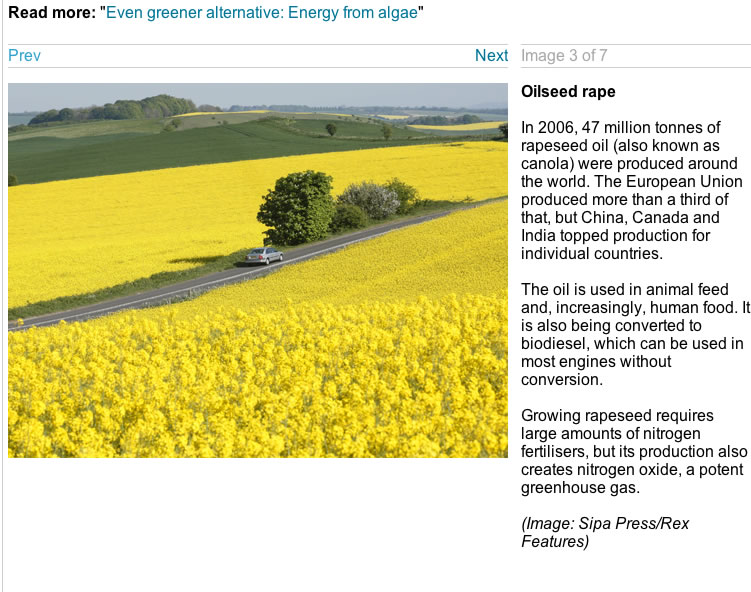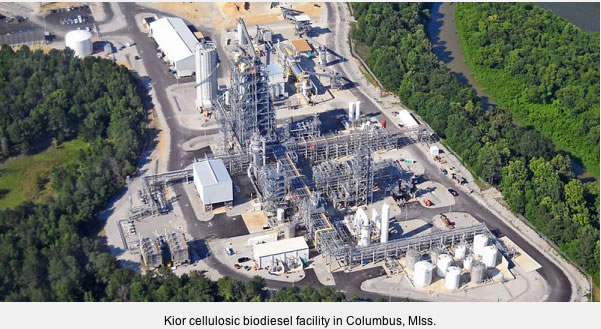Bio-diesel Fuels
Bio-diesel can be made from almost any oily vegetable, or from animal fat. It is made is large volumes from soy beans (in the US and Brazil), and rapeseed in Europe. It is also made from Palm, flax, sunflower, coconut oils, and many other plants. One of the most ecological sources is used vegetable oil (WVO). Animal fats include tallow, lard, yellow grease and chicken fat. Interestingly it is also possible to make bio-diesel from sewage sludge.
1. Diesel engines and their fuels
Diesel engines can run on a remarkably wide range of fuels. One thing in common however, is that the fuels have more carbon atoms in their chain than gasoline does. Because there is most often insufficient oxygen to combine all of these carbon atoms, a high level of free carbon (soot) is emitted. The picture below, sadly, is real and not that uncommon in older diesels. This unacceptable situation has finally been addressed by the auto manufacturers with their, so called, 'new diesels'; but only partially addressed. Evidence to this point is that our EPA now requires two very expensive post engine add-ons in the exhaust piping of diesel engine vehicles. One is the diesel particulate filter DPF, which reduces the soot you see below, and the other is the urea filter, which reduces the high level of NOx you don't see in that exhaust. The DPF must be cleaned periodically, and is automatically done so by burning diesel fuel to burn off the carbon that clogs it. The urea filter must be refilled periodically with a costly urea solution. All together the emissions you see below are drastically reduced. But even so they are still not acceptable in heavily used urban areas. We will explore whether bio-diesel acts to solve these problems. To give you advance notice of the conclusions, overall we would like to completely eliminate the need for diesel engines, and this is possible by using high percentages of alcohols in spark ignited engines. In fact, even higher thermodynamic efficiencies are possible in alcohol engines.
2. Bio-diesel from vegetable oils
Very much in a way that we think about how good cellulosic ethanol would be if we could make it economically, making methanol from organic wastes is a real economic proposition now!

3. Bio-diesel positive attributes
1. Renewable, but can't be an overall solution because there isn't enough land. But research in manufacture from wastes might change that.
2. High efficiency of the diesel engine.
3. Aviation fuel
4. Can be made from algae.
4. Bio-diesel downsides
1. The energy balance is a big negative.
2. Since Palm and Coconut produce the most gallons per acre, there has been pressure to deforest virgin tropical forest to plant Palms (Palms produce 6-8 times as much oil). The Environmental Protection Agency (EPA) published data in January 2012, showing that bio-fuels made from palm oil won’t count towards the nation’s renewable fuels mandate as they are not climate-friendly.
3. Food vs. fuel. Farmers may switch from producing food crops to producing bio-fuel crops to make more money, even if the new crops are not edible. This is a similar problem to as the use of corn to make ethanol.
3. High NOx
4. High concentration of particulate matter.
5. Proliferation of the diesel engine.
6. Bio-diesel requires about 10% by volume of methanol.
As we shall show, the efficiency of diesel engines can be outdone by using high percentage blends of either methanol or ethanol, or a blend of both with some gasoline.
Much more coming. Linking to the bio-diesel wiki sight
http://en.wikipedia.org/wiki/Biodiesel#Biodiesel_feedstocks
will give a good review of current bio diesel views.
5. Cellulosic Diesel
As we noted in the Fuels overview, 2013 is going to be the year of the first commercialization of various cellulosic based fuels. Of course, cellulosic fuels do not have the issues discussed above.
The first to go on-line appears to to Kior.
5.1. Kior, Inc.
Their announcement:
Kior Ships First Cellulosic Diesel March 18, 2013. Mississippi Facility Uses Pine Wood Chips – No Food.
Pasadena, Texas-based Kior, Inc. reports initial shipments of the world’s first cellulosic biodiesel from its first commercial-scale facility in Columbus, Miss. Kior uses pine wood chips previously that previously fed a now-shuttered Columbus paper mill. Kior’s gasoline and diesel are “the first renewable hydrocarbon fuels in the U.S. manufactured at commercial scale and derived solely from non-food feedstocks to avoid competition with human food needs,” the company says.

“Unlike traditional biofuels like ethanol or biodiesel, Kior’s fuels have no compatibility issues,” Kior says. The firm (NASDAQ:KIOR) further claims the first renewable cellulosic gasoline to be registered by the U.S. EPA. “This is a major step forward for Kior, the biofuels industry and the entire renewable fuels sector,” Kior president and CEO Fred Cannon says in a release. Kior president and CEO Fred Cannon talks about ‘the Holy Grail of renewable fuels… no disruption to the existing infrastructure.’ “With first production at Columbus, Kior has technology with the potential to resurrect each and every shut down paper mill in the country and to replace imported oil on a cost effective basis while creating American jobs,” Cannon said. “This facility demonstrates the efficacy of Kior’s proprietary catalytic biomass-to-fuel process with the potential to deliver cellulosic gasoline and diesel to the U.S. We are proud to be making history in Mississippi. The technology is simply scalable and we believe sufficient excess feedstock exists in the Southeast alone to build almost fifty Kior commercial scale facilities.” Kior says too, that its fuels are identical to petroleum based fuels made from conventional methods and will drop in to the existing fuels infrastructure; that studies show that Kior fuels will have a significant reduction in lifecycle greenhouse gas emissions when compared to fossil-based fuels… comparable to or better than electric cars run off the U.S. electric grid; and that construction and operation of production facilities provides significant economic development in rural areas.
.

